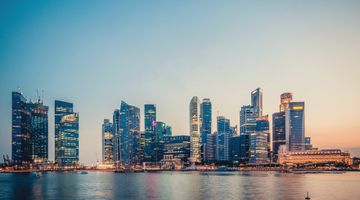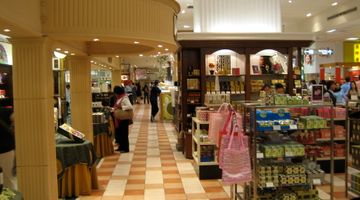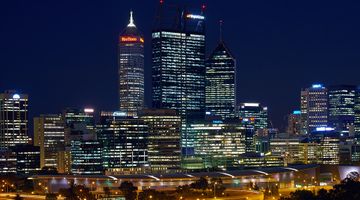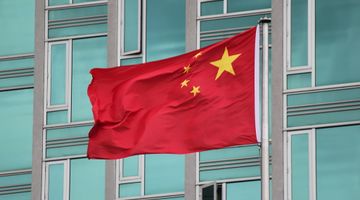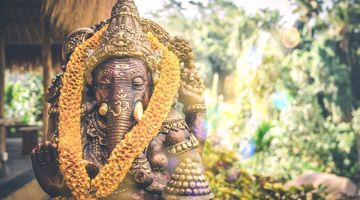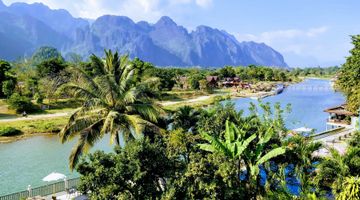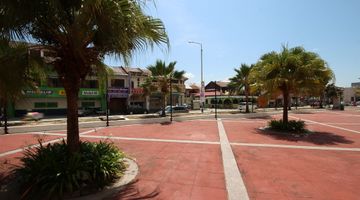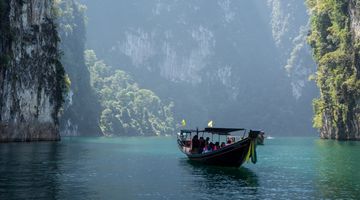Singapore Travel Guide. Where you should go in 2025?
Singapore is globally known for its exceptional organization, iconic skyline, and city life. Its sleek, modern architecture blends seamlessly with gardens and nature reserves.
This unique mix offers both urban attractions and natural beauty. In this travel guide, we summarize the top must-see places and highlights that make Singapore a premier tourist destination. Small Singapore has a lot to offer.
To get to know Singapore better, you can go beyond its famous showcase and visit different island areas. With impressive architecture, world-class museums, endless shopping malls, famous gardens, and an unrivaled culinary scene, Singapore is a year-round tourist paradise.
When is the best time to go to Singapore?
Singapore doesn’t do seasons — it’s tropical all year. Expect hot, humid days with quick, heavy rain that rarely lasts long or affects your plans. Singapore is located near the equator, so it has an equatorial climate. With this location, temperature fluctuations are barely felt throughout the year.
The amount of precipitation also does not change significantly. This island enjoys a warm climate year-round, with daytime highs of 29 degrees. The "dry" period is considered to be the summer months, and the season with an increased probability of precipitation is November, December, and January.
Why should you visit Singapore?
Thrilled to participate in local festivals? Go to Singapore! Despite being a secular nation, as a result of its flourishing multicultural population, Singapore acknowledges and celebrates Chinese, Buddhist, Hindu, Muslim, Indian, and Christian holidays.
Visitors will be thrilled to realize that a variety of lively festivals and unforgettable events are hosted throughout the year in Singapore. These cultural and festive occurrences, rich in tradition and significance, are an excellent reason to visit Singapore.
Deepavali, Eid ul-Fitr, Christmas, Vesak Day, Hungry Ghost Festival, Dragon Boat Festival, Singapore Fashion Week, Singapore Food Festival, and National Day are just a few cultural treats on offer. Kick off the year with the Chinese New Year.
With Chinese residents making up three-quarters of the population, it is easily the most celebrated and anticipated festival of all. The exquisite Chingay Parade occurs ten days later with street performers, elaborately decorated floats, and dancers in traditional costumes all parading in a colourful explosion of pulsating exuberance down the well-known Orchard Road.
Shopaholics, look no further: Singapore is your dream destination
Shopping is a national pastime here in Singapore, and visitors will have a dizzying array of retail therapy options. From the sheer abundance of shopping malls to flea markets to the finest boutiques shopaholics will be spoilt for choice at any budget.
For the very latest in design, peruse the goods at Dover Street Market; for trendy, artsy treasures head on over to Tiong Bahru and if you’re looking for the crème de la crème of shopping experiences, be sure to check out the 2.2km shopping strip on the famous Orchard Road.
Keep your ear to the ground during June and July for the Great Singapore Sale where everything is massively discounted and shops are open until wonderfully late. Food is also a fine thing to combine your shopping frenzy with. Due to the fusion of cultures in Singapore, the culinary delights on offer will send you salivating across the country. From street food venders to fine-dining options, the food in Singapore is world-famous for a reason.
It is not just skyscrapers; Singapore’s calling all nature lovers, too
All fauna and flora fanatics would relish and appreciate a trip to Singapore to admire the expansive strips of greenery and wildlife.
Taking into account the legendary skylines of Marina Bay and the Civic District, before seeing Singapore yourself, it’s easy to wonder how on earth this city glittering with looming skyscrapers can aspire to its “garden city” promises of eco-attractions.
But nature lovers will be delighted to note that not only do the sprawling gardens and parks live up to one’s expectations, but they exceed them.
Singapore has an enchanting network of inspiring national parks, the Singapore Botanic Gardens, the highly acclaimed Gardens by the Bay, jungles of Pulau Ubin; as well as the family-friendly, (almost) cageless Singapore Zoo.
Singapore attractions
Must-see spots? Start with Gardens by the Bay – giant supertrees, misty domes, pure sci-fi. Head to Marina Bay Sands SkyPark for skyline views that live up to the hype. Sentosa has beaches, rollercoasters, and a cable car ride worth admiring.
Wander through Chinatown and Little India for street food and non-stop colour. Haji Lane? Tiny, bright, full of murals and cool shops. And don’t miss the Botanical Gardens – lush, quiet, and calm in the middle of it all.
Gardens by the Bay
A futuristic park with giant “Supertrees,” hanging walkways, and two unique conservatories: the Cloud Forest, filled with mist and a man-made waterfall, and the Flower Dome—the largest glass greenhouse in the world. Located in Downtown Singapore.
With the unique and spectacular ‘Supertrees’, Flower Dome, Cloud Forest and many other attractions on display, this 101-hectare garden in Singapore is unlike any most visitors have encountered before.
The purpose of creating this green oasis within the city was to boost and enrich the quality of life for visitors and locals with increased flora and greenery. Sunsets from Gardens by the Bay of Singapore’s iconic skyline and waterfront views are also exquisite and offer excellent photography opportunities.
Marina Bay Sands
Marina Bay Sands is a luxury hotel famous for its panoramic infinity pool on the roof. Just above it, the SkyPark observation deck offers breathtaking views of the entire city. A walk along the nearby waterfront is one of the best ways to experience the vibrant atmosphere of Singapore.
For those visitors who came to Singapore to admire its meticulously run city, there are superb city attractions competing for your attention amongst the natural wonders, too. Arguably the most familiar and recognized building in the country, Marina Bay Sands is a must-visit attraction for visitors who love architecture and contemporary design.
This building is a seamless integration of a hotel, a shopping mall, and an art museum. Throw in the infinity pool, observation deck, and the bar, all with breathtaking views of the city, and you have yourself a perfect day.
Singapore Botanic Gardens
Continuing with the theme of must-see nature attractions and natural places to visit in Singapore, is the 158-year-old Singapore Botanical Gardens. This is the only tropical garden to be bestowed the honor of being a UNESCO World Heritage Site.
Located on Cluny Road on the edge of the famous Orchard Road shopping area, this beautiful green paradise is the ideal spot for picnics and admiring Singapore’s national flower – the orchid. The National Orchid Garden has a famous collection of more than 1000 species of this beautiful flower and spans over a 3-hectare site.
Jewel Changi Airport
One of the most stunning airports in the world. Inside: Rain Vortex, a 40-metre waterfall surrounded by indoor gardens, tropical greenery, shops, and cafes.
Forest Valley has over 2,000 trees, walking trails, waterfalls, and quiet places to relax.
It’s not just beautiful, it’s also fun: hanging nets, art installations, a glass bridge, and a mirror maze right in the middle of it all.
Clarke Quay is a waterfront spot full of bars, restaurants, and nightlife. Take a river cruise and see the city from the water.
Singapore Zoo
Night Safari and Singapore Zoo are among the best zoos in the world. The Singapore Zoo is set on 26 hectares of a lush peninsula. It is one of the oldest botanical gardens in Asia. Get up close with orangutans and see Malaysian flying foxes.
The Singapore Zoo is home to the world's largest population of orangutans and a collection of tropical birds that beggars imagination.
Singapore Zoo has been voted as the most picturesque and scenic zoo in the world. Animals roam somewhat freely in (almost) cageless settings that perfectly mimic the animal’s natural habitat.
This award-winning zoo is home to more than 2,800 animals and over 300 species of mammals, birds, and reptiles. All four of these exceptional attractions are managed by the Wildlife Reserves Singapore, and a ticket for admission into all 4 of these spots, namely, the Jurong Bird Park, the Night Safari, River Safari, and the Singapore Zoo, will cost SGD 69 for adults and SGD 49 for children.
Singapore Flyer
The Singapore Flyer is a giant Ferris wheel with views that stretch far beyond the horizon. On a clear day, you can see parts of Malaysia and Indonesia. It’s slow, smooth, and a little surreal.
Visa in Singapore
Most travellers can enter Singapore without a visa for short stays, but this depends on your nationality. Some passport holders require a Singapore visa, which is usually valid for 30 days and must be applied for in advance through a local representative or authorised agent.
SG Arrival Card
All visitors must provide an SG Arrival Card (online immigration form) within 3 days of arrival. It is fast, free, and mandatory.
To enter Singapore, ensure you have:
- A passport valid for at least 6 months
- Your Singapore Arrival Card
- Proof of onward/return travel
- Sufficient funds for your stay
- Yellow fever vaccination is required if you have recently been to a high-risk country.
Citizens of 162 jurisdictions can enter Singapore without a visa for tourism or business purposes.
Length of stay varies:
1) 90 days: Applicable to citizens of countries such as the United States, United Kingdom, Canada, Australia, New Zealand, and most European Union member states.
2) 30 days: Applicable to citizens of countries such as Malaysia, Japan, South Korea, Thailand, Indonesia, and others.
Citizens of certain countries are required to obtain a visa before entering Singapore. This includes citizens of countries such as Afghanistan, Bangladesh, Democratic People's Republic of Korea (North Korea), India, Iran, Iraq, Nigeria, Pakistan, Somalia, Sudan, Syria, Yemen.
Singapore Transportation
By air
There are daily direct flights between Singapore, Europe, North America, to South Africa; the Middle East to Australia, and so on.
Singapore is also a common stopover on the “Kangaroo Route” between Australia and Europe with KLM, British Airways, Etihad Airways, Mann Travel and Emirates.
Singapore-based low-cost carriers such as Tiger Airways, Scoot and Jetstar Asia, Singapore Airlines and Silk Air make travelling around the region easy and affordable.
Changi Airport is a well-organized, efficiently run and first class experience for all. State of the art design, remarkably fast immigration and baggage services, and absolutely beautiful, it’s clear to see why this airport has been dubbed, “the airport of the world”.
By land
You can enter or exit Singapore overland via two crossings: the Causeway and the Second Link. The Causeway is busier, especially on Fridays and Sundays, and can be crossed by bus, train, taxi, or car.
The Second Link, connecting Tuas to western Johor, is less congested and faster—ideal for driving or luxury buses to Kuala Lumpur. Both routes charge small tolls, but driving into Malaysia is generally easy.
You can get to and from Singapore by bus from Kuala Lumpur and other Malaysian cities via the Woodlands Checkpoint or the Second Link at Tuas. There’s no central bus station in Singapore, so each company departs from different locations.
KKKL leaves from Katong V, Golden Coach from City Plaza, and Transtar (a more upscale option) from Golden Mile Complex. Seasons Express, a cheaper alternative, also departs from there. Fares range from MYR50 to MYR120 (SGD20–45). The more you pay, the smoother and quicker the ride—often with no stops and a faster border crossing. The trip takes about five hours.
Train travel between Singapore and Malaysia is possible via the Shuttle Tebrau, operated by KTM, running between Woodlands Train Checkpoint and JB Sentral in Johor Bahru. Though less frequent and pricier than buses, it avoids traffic and has faster immigration checks. There are 14 daily trips from JB and 12 from Singapore. Note: There’s no longer a direct train beyond Johor—you’ll need to transfer via JB and Gemas.
You can reach Indonesia’s Batam and Bintan or Johor, Malaysia by ferry from Singapore. Ferries depart from five terminals, mainly HarbourFront and Tanah Merah. Trips take 1–2 hours and run frequently. Operators include Batam Fast, Penguin, and Berlian.
How to get around Singapore?
Getting around Singapore is easy, clean, and efficient, with the MRT and LRT rail systems covering most attractions.
Traffic in Singapore keeps to the left, and public transport operates on a schedule. The entire island is connected by MRT (subway) and buses.
The metro system has over 130 stations and operates from 5:30 a.m. to midnight, with trains running every two to three minutes during peak hours and approximately every five to seven minutes during off-peak hours. The fare depends on the distance and usually doesn’t exceed S$2.
The best way to use public transport is with an EZ-Link or NETS FlashPay card, valid for both trains and buses.
Buses are slower but offer scenic routes and cheaper fares; just tap your card when boarding and alighting. Taxis are metered, reliable, and safe, though occasionally hard to find—booking ahead during peak hours is smart.
Walking is convenient thanks to pedestrian-friendly roads, and trishaws offer short tourist rides around Chinatown and the riverfront.
Kick scooters are a fun, affordable option for exploring areas like Clarke Quay and are allowed on MRT and sidewalks. For something different, take a bumboat cruise along the Singapore River or to Pulau Ubin.
How to get from Singapore to Kuala Lumpur?
Getting from Singapore to Kuala Lumpur is easy. Most travelers choose the bus – it’s direct, runs several times a day, and offers comfy VIP seats. Tickets start from SGD 20, with luxury options around SGD 50.
Trains require two transfers (Johor Bahru and Gemas) and take about 10 hours total. Flights are the fastest, just 1 hour in the air, with prices from SGD 80 for low-cost carriers.
The road distance is around 360 km, and buses usually take 5–6 hours, depending on traffic and terminals. If you're not flying, buses are the most convenient option.
How to get from Singapore to Johor?
Getting from Singapore to Johor is easy and cheap. Most travelers take the bus—it's reliable, runs often, and costs around $60. Ferries are more scenic (from $65), but less frequent and slower.
Taxis are the most flexible option, starting from $150 for a private transfer—great if you're traveling in a group. Flights exist but aren’t practical for such a short route. The distance is about 75 km, and travel time ranges from 2 to 3 hours by land, depending on traffic. Most people choose the bus—fast, direct, and budget-friendly.
How to get from Singapore to Penang?
You can travel by flight, bus, train, or taxi. Flights are fastest (about 1.5 hours), while buses are the cheapest option. Expect travel time between 5–18 hours, depending on the method.
Bus: From $44, about 12 trips daily. Comfortable and affordable, but slower.
Flight: From $218, with 4 departures per day from Seletar.
Taxi: Direct and flexible but pricey – up to $832.
Train + bus: Cheapest combo from $23, but takes the longest.
Most travelers choose the bus for its balance of comfort and price.
How to get from Singapore to Ipoh?
You can travel from Singapore to Ipoh by flight, bus, or taxi. Flights are the fastest option, taking around 1.5 hours, while buses are more affordable and take longer. The full journey can take between 2 to 15 hours, depending on the transport mode.
Bus tickets start from around $29, with 37 trips available daily. Flights start from $94, with about 13 departures each day. Taxis are the most expensive, costing up to $686 for a one-way trip.The distance between Singapore and Ipoh is 454 miles (729 km) by land. Most travelers prefer taking the bus.
How to get from Singapore to Genting Highlands?
You can travel from Singapore to Genting Highlands by bus or taxi. Buses are the most popular and affordable option, with ticket prices starting around $32 and up to 20 departures daily. The trip takes between 5 to 10 hours, covering a distance of about 150 miles (241 km).
Taxis offer a faster, more flexible option, but prices range from $313 to $501 one way. Most travelers prefer buses for their value and convenience. Booking in advance is recommended for better seats and prices.
How to get from Singapore to Batam?
The easiest way to get from Singapore to Batam is by ferry. Ferries operate daily from HarbourFront and Tanah Merah terminals to Batam Center, Harbour Bay, or Sekupang. The journey takes about 45-60 minutes and costs about US$28-33. Operators include Batam Fast Ferry, Sindo Ferry, and Majestic Fast Ferry.
Where to go if you like...
Singaporean Art and History
Arts and culture enthusiasts will take great pleasure in knowing that Singapore is rich in a variety of superb art galleries and museums that are sure to pique the interest of even the most reluctant museum-goer.
The Bras Nasah area, north of the Singapore River, is the city’s colonial centre for must-see museums and historical architecture. Art galleries such as the National Gallery, the Singapore Art Museum focusing on East-Asian art, and the Esplanade theatre (a common stage for the Singapore Symphony Orchestra) are fantastic experiences and top highlights on one’s travel itinerary.
Steeped in history and tradition, any trip to Singapore should involve a visit to the National Museum of Singapore, and if you like your art fused with science then look no further than the Art
Science Museum at the Marina Bay Sands.
Dinosaur devotees, natural history and fossil aficionados will also be thrilled to know that there is the Lee Kong Chian Natural History Museum where the silence is sporadically punctuated by the roar of a dinosaur.
Temples and Religion in Singapore
Temples are yet another fascinating attraction luring history buffs to the City of the Lion. Due to the complete religious freedom of its citizens, Singapore has gorgeous temples and churches inspired from the numerous national religions.
Buddhism, Taoism, Christianity, Islam and Judaism all have places of worship in Singapore and visitors can engage in wonderful cultural experiences by exploring the streets and alleyways of Little India, Chinatown and Kampong Glam/Arab Street.
The Chinatown Heritage Centre can be explored in Chinatown and the Buddha Tooth Relic Temple and Museum is also well worth a visit. Head on over to Bright Road to discover Singapore’s largest temple of all - Kong Meng San Phor Kark See Temple, also known as Bright Hill Temple.
Family-friendly activities in Singapore
If you’re in Singapore on a family holiday then you’ll be happy to know that there are many family-friendly activities that members of all ages and interests will revel in.
As already mentioned, there is the Singapore Zoo, which little ones are sure to delight in, and if this gets the nod of approval, then be sure to check out Jurong Bird Park, Marine Life Park at Sentosa as well as the night and river safaris in Mandai.
Another huge hit with families visiting Singapore are the assortment of theme parks and water parks. Universal Studios Singapore, located on Sentosa Island is bursting at the seams with thrilling rides, exciting attractions and captivating shows; and promises to live up to its claim of being a "one-of-a-kind theme park in Asia".
Snow City located within the Science Centre allows visitors to experience real snow and a three-story high snow slope in a sub-zero climate. All water-babies should definitely check out Adventure Cove Waterpark also located on Sentosa Island as well as Wild Wild Wet and Jurong East Swimming Complex.
Nature & Treking
Calling all nature junkies! With Singapore’s glittering and futuristic skyscrapers, it can be difficult to imagine that this city offers much in the way of natural attractions. However, Singapore merges concrete and nature in an eco-friendly, creative and mesmerising way and nature lovers will still be able to soothe their souls amidst the high-rise buildings and shopping complexes.
Already mentioned and yet worth repeating are the beautiful parks of Singapore as well as the beaches. The many beaches on Sentosa Island are fantastic for those craving a bit of relaxation amongst the rollercoasters and indoor skydiving. For a more local experience, head over to eastern Singapore for a more rustic beach experience.
Food in Singapore
Singapore is all about food. Its multicultural cuisine is a source of national pride. The famous hawker centres (street food courts) are included on the UNESCO list of intangible cultural heritage.
Singaporean cuisine is a collection of popular dishes from various countries, including Malay, Chinese, Indonesian, Indian, Peranakan, and even European, Thai, Filipino, and Middle Eastern influences.
Breakfast usually means kaya toast: two slices of crispy toasted white bread with a layer of sweet-salty butter or margarine and kaya jam in between. Add two soft-boiled eggs and a cup of coffee or tea, and you've got the full set. Kaya jam is made from coconut milk, pandan, eggs, and sugar, and is often bought as a souvenir.
Congee is a rice porridge with a variety of add-ins: shiitake mushrooms, pork meatballs, century eggs, fish, peanuts, or ginger.
Chilli Crab is a mangrove crab cooked in a sweet and spicy tomato-chili sauce. Prices range from S$50 to S$200 per crab.
Oyster Omelette (Orh Luak) is made by frying small oysters with potato starch and eggs. Served with a tangy chili-lime sauce on top.
Nasi Lemak is coconut and pandan-infused rice served with spicy sambal chili sauce and assorted sides. The rice is usually shaped into a small mound and placed on a plate, banana leaf, or paper wrap, with the hot sauce poured around it.
Facts about Singapore
-
City-state with four official languages
Singapore has four official languages: English, Chinese, Malay, and Tamil. -
One of the greenest cities in the world
More than 50% of Singapore’s land area is covered in greenery. The city actively promotes vertical gardening and the development of “green buildings.” -
Very strict laws
Singapore is known for having some of the strictest laws in the world. Offenses like littering, vandalism, or smoking in non-designated areas can result in hefty fines or even corporal punishment.
Singapore Travel Tips
Singapore’s sleek skyline and luxury vibe can make it seem like a destination only for big spenders — and yes, it is more expensive than places like Bangkok. But budget travel in Singapore is possible with a bit of planning:
Dorm rooms are the main option for budget stays, and while food isn’t as cheap as Bangkok’s street eats, affordable local meals can still be found.
Compared to Hong Kong, prices are similar, and with some research, you can enjoy the city without breaking the bank.
While independent travel has its charm, prearranged tours in Singapore can be cheaper once you factor in transport, transfers, and entry fees.
Travel with friends or family to split accommodation and taxi costs.
Save on food by eating at hawker centres where meals cost SGD 3–10.
Find drink deals at Clarke Quay, known for two-for-one specials.
Drink tap water—it’s clean and safe.
Use combination attraction passes for discounted entry to sights and bars.
Choose hostels or couchsurfing over hotels.
Shop and eat cheaply at Bugis Street Market, Mustafa Centre, and Lucky Plaza.
Get an EZ Link Card (SGD 12, SGD 5 refundable) to save on MRT fares.
FAQ
- What currency is used in Singapore? The Singapore Dollar (SGD). Credit cards are widely accepted, but it’s good to have some cash for hawker stalls and small vendors.
- Is Singapore expensive? Yes, it’s one of Southeast Asia’s more expensive destinations. However, budget travel is possible—look for hawker food, EZ-Link cards for transport, and free attractions like Gardens by the Bay (outdoor areas).
- Is Singapore safe? Yes, Singapore is one of the safest cities in the world. Still, use basic precautions as you would anywhere.
